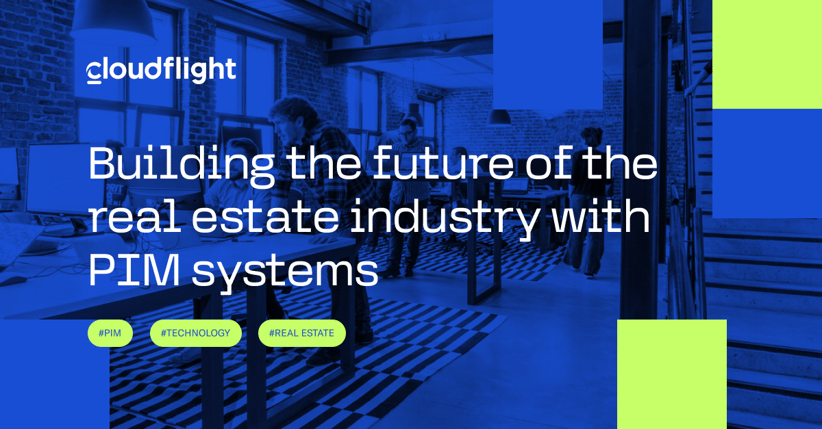In the fragile economic landscape that we’re currently experiencing, it’s only natural that individuals and businesses alike are reluctant to make big investments. This puts the real estate and construction industries, which were built upon transactions on a massive scale, in a difficult position. The business models perfected over the years might simply not work anymore, and agility needs to be at the forefront moving forward.
It’s not only the business approach that needs to change, though. Evolving strategies must be accompanied by the right technology that will help streamline processes and make positive customer experience more accessible. This is where modern product information management (PIM) systems, such as Pimcore, shine.
Over many success stories, PIM technology has been proven to increase operational efficiency and open up new possibilities for businesses in the real estate and construction sector. Here are three that best showcase the potential of PIM solutions.
Reliable infrastructure for sharing economy business models
Although the initial boom seems to have quieted down, the concept of a sharing economy is still going strong. The current economic downturn makes developers less likely to make big investments, which makes alternative business models an attractive proposition. The real estate industry, with its ever-growing barrier to entry, seems particularly well suited for this approach. New businesses that describe themselves as “Airbnb, but for…” seem to be popping up every day.
However, businesses that aim to succeed in this sphere need more than just a good idea. It needs to be supported by a capable infrastructure that will bring it to life. This usually means storing and processing large amounts and varieties of data that tend to be not too different in structure from typical product information.
Success story: WelcomeMat
WelcomeMat, based in Australia, can be summarized as Airbnb for affordable rental housing. It matches landlords with potential tenants based on their preferences and then automates the processing of their applications and assessing eligibility.
Challenge: balancing ease of use with technical prowess
Ease of use and efficiency are the key factors that make or break businesses built around the principle of the sharing economy, and WelcomeMat was no different. Their top priority was to streamline the tenant matching and qualification process to such a degree that it could become fully automated and online with no need for any physical paperwork. This, in turn, meant they needed to create a system that would be easy to use on the front end and, at the same time, robust at the back end to process a large amount of required information.
Solution
Although this isn’t a typical use of PIM software, WelcomeMat decided to build their web solution with Pimcore as the foundation. The system allowed them to efficiently store and process vast amounts of data related to properties, landlords, and tenants, and feed it to the intelligent matching algorithm.
Image source: WelcomeMat
The automated system greatly reduced the time needed to process an application. It cuts down on manual tasks and paperwork, which streamlines the entire process and reduces the potential for human errors.
The Pimcore-based solution is a win for all parties involved:
- It offers an efficient application process for renters.
- It simplifies the assessment process for landlords.
- It facilitates the seamless matching of landlords and renters.
- It consolidates all relevant information within a secure platform.
Performance and agility
Modern businesses tend to consider their offices as more than just workspaces. They’re places where employees can wind down during or after work hours, organize events and other collaborative initiatives, and facilitate learning and development. They cater to various needs and preferences on both an individual and company-wide level. In short, they’re agile.
Cloudflight office in Wroclaw
In parallel with this evolution of physical offices, the online presence of businesses that specialize in them needs to reflect similar qualities. In order to create the right image, their websites must be high-performing, responsive, and intuitive. This is another area where a capable PIM system can make a difference.
Success story: hellomonday
hellomonday specializes in brokering office properties in Hamburg, Germany. They take pride in precisely assessing and responding to their clients’ needs in terms of office space, so much so that Monday becomes a day to look forward to.
Challenge: unmaintained infrastructure
hellomonday had already been using Pimcore prior to the project. However, even the very best system runs into problems if the infrastructure that it’s built upon isn’t properly maintained and updated. This is exactly what happened in this case. Their website started to experience serious hiccups in overall performance, and, above all else, data transfers between various modules had trouble reaching their targets. Obviously, this isn’t a good look for any business, but it was even more problematic for hellomonday given the image they were trying to create. It was clear that things needed to improve urgently.
Solution
Pimcore is inherently a highly flexible platform. This meant that it could remain the foundation of hellomonday’s ecosystem and reduce the amount of work that was necessary. The project started with updating the infrastructure to eliminate performance bottlenecks and then moved on to implement new features that further improved the user experience.
As a result, the website’s time to market improved by 20%, and the overall technical performance jumped by an impressive 50%. In most cases, improvements this big suggest that the entire “engine” of a website has been swapped during a massive project. This, however, was one of the rare cases where such changes weren’t necessary because Pimcore was able to seamlessly accommodate the improved infrastructure and new features.
A digital showroom experience
Building, well, a building, is one of the most complex projects you can undertake. Beginning with questions related to layout and function, through technologies and materials, to aesthetics and other finishing touches, every stage requires a large amount of specialist knowledge and problem-solving skills. Traditionally, this process would come down to many meetings and long discussions with various contractors and visits to showrooms. But what if you tried to take it all online?
This question is becoming more and more pressing for real estate and construction businesses. Modern customers expect to be given the choice between in-person and online experiences whenever possible, and the industry needs to figure out how to translate the delicate processes into the digital sphere. A large part of the answer is the concept of a digital showroom. Websites built in this convention create more in-depth and engaging experiences with products than traditional product pages. They’re capable of leveraging advanced types of media, such as detailed 3D models, that can be a game changer in bringing construction projects online.
Success story: Baufritz
Baufritz is a manufacturer of prefabricated timber houses originating from the picturesque Allgäu region of Germany. They deliver houses to seven countries, which means that clients can’t always expect a Baufritz representative to be nearby. Because of this, their website plays a crucial role in the process of planning and selection of materials.
Challenge: creating a valuable planning resource
Prior to the big makeover, Baufritz’s online presence was a standard corporate website, just like every other business’s. The company wanted something more. They imagined a personalized resource that would first assist clients with making the initial choices in terms of layouts, materials, and the like, and then guide them through the rest of the process until the house is set up on their lot.
Solution
Baufritz built their new website with Pimcore in the back end. The ability to use sophisticated media types allowed them to set up an elaborate showroom experience that's as close to seeing and touching products in person as realistically possible.
Image source: Baufritz
Their approach to personalization is especially interesting. Baufritz realized that different clients become interested in their houses for different reasons: some are impressed by the innovative technology, while others like the design or the functionality. Keeping this in mind, they offer several paths that guide the visitors, each starting with the relevant feature.
Laying solid foundations for changes
When used to their full potential, PIM systems can play a crucial role in reshaping the real estate and construction industries. Whether streamlining the tenant matching process, revamping online presence, or creating immersive digital showrooms, these cases underscore the need for adaptable infrastructures that align with evolving business models.
The current economic climate and evolving customer expectations are forcing changes in the real estate and construction sectors, but if approached correctly, they can lead to positive outcomes for all parties involved. As businesses embrace technological solutions, they can become synonymous with innovation, efficiency, and a redefined customer experience.
The list of benefits, however, goes on, and this article is only meant to give you a taste of the key ones. We've recently released an eBook that goes over more applications and benefits of PIM software in the real estate industry. Make sure to have a look to get a complete picture of what such implementations can accomplish for your business.
Published November 27, 2023











